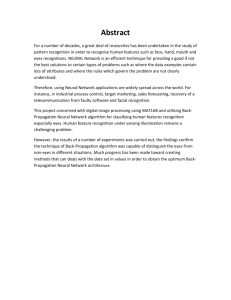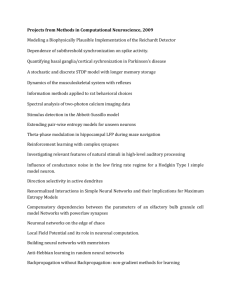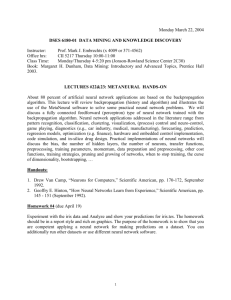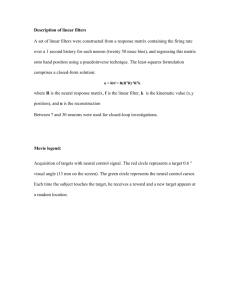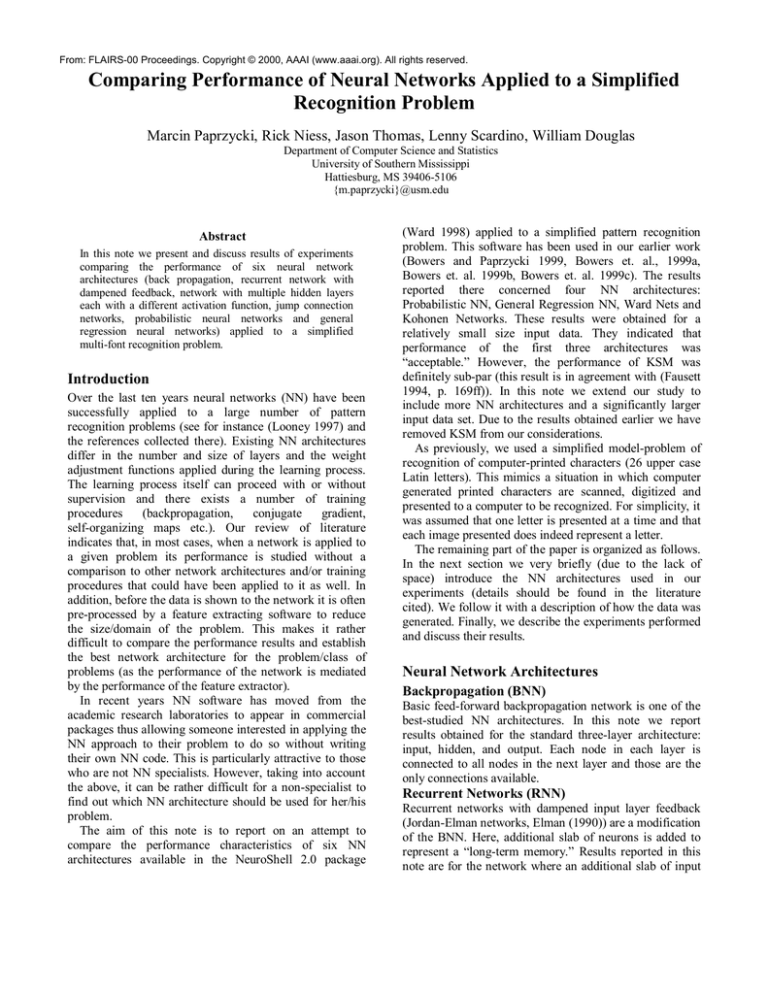
From: FLAIRS-00 Proceedings. Copyright © 2000, AAAI (www.aaai.org). All rights reserved.
Comparing Performance of Neural Networks Applied to a Simplified
Recognition Problem
Marcin Paprzycki, Rick Niess, Jason Thomas, Lenny Scardino, William Douglas
Department of Computer Science and Statistics
University of Southern Mississippi
Hattiesburg, MS 39406-5106
{m.paprzycki}@usm.edu
Abstract
In this note we present and discuss results of experiments
comparing the performance of six neural network
architectures (back propagation, recurrent network with
dampened feedback, network with multiple hidden layers
each with a different activation function, jump connection
networks, probabilistic neural networks and general
regression neural networks) applied to a simplified
multi-font recognition problem.
Introduction
Over the last ten years neural networks (NN) have been
successfully applied to a large number of pattern
recognition problems (see for instance (Looney 1997) and
the references collected there). Existing NN architectures
differ in the number and size of layers and the weight
adjustment functions applied during the learning process.
The learning process itself can proceed with or without
supervision and there exists a number of training
procedures
(backpropagation,
conjugate
gradient,
self-organizing maps etc.). Our review of literature
indicates that, in most cases, when a network is applied to
a given problem its performance is studied without a
comparison to other network architectures and/or training
procedures that could have been applied to it as well. In
addition, before the data is shown to the network it is often
pre-processed by a feature extracting software to reduce
the size/domain of the problem. This makes it rather
difficult to compare the performance results and establish
the best network architecture for the problem/class of
problems (as the performance of the network is mediated
by the performance of the feature extractor).
In recent years NN software has moved from the
academic research laboratories to appear in commercial
packages thus allowing someone interested in applying the
NN approach to their problem to do so without writing
their own NN code. This is particularly attractive to those
who are not NN specialists. However, taking into account
the above, it can be rather difficult for a non-specialist to
find out which NN architecture should be used for her/his
problem.
The aim of this note is to report on an attempt to
compare the performance characteristics of six NN
architectures available in the NeuroShell 2.0 package
(Ward 1998) applied to a simplified pattern recognition
problem. This software has been used in our earlier work
(Bowers and Paprzycki 1999, Bowers et. al., 1999a,
Bowers et. al. 1999b, Bowers et. al. 1999c). The results
reported there concerned four NN architectures:
Probabilistic NN, General Regression NN, Ward Nets and
Kohonen Networks. These results were obtained for a
relatively small size input data. They indicated that
performance of the first three architectures was
“acceptable.” However, the performance of KSM was
definitely sub-par (this result is in agreement with (Fausett
1994, p. 169ff)). In this note we extend our study to
include more NN architectures and a significantly larger
input data set. Due to the results obtained earlier we have
removed KSM from our considerations.
As previously, we used a simplified model-problem of
recognition of computer-printed characters (26 upper case
Latin letters). This mimics a situation in which computer
generated printed characters are scanned, digitized and
presented to a computer to be recognized. For simplicity, it
was assumed that one letter is presented at a time and that
each image presented does indeed represent a letter.
The remaining part of the paper is organized as follows.
In the next section we very briefly (due to the lack of
space) introduce the NN architectures used in our
experiments (details should be found in the literature
cited). We follow it with a description of how the data was
generated. Finally, we describe the experiments performed
and discuss their results.
Neural Network Architectures
Backpropagation (BNN)
Basic feed-forward backpropagation network is one of the
best-studied NN architectures. In this note we report
results obtained for the standard three-layer architecture:
input, hidden, and output. Each node in each layer is
connected to all nodes in the next layer and those are the
only connections available.
Recurrent Networks (RNN)
Recurrent networks with dampened input layer feedback
(Jordan-Elman networks, Elman (1990)) are a modification
of the BNN. Here, additional slab of neurons is added to
represent a “long-term memory.” Results reported in this
note are for the network where an additional slab of input
neurons was included. This slab combines inputs from the
external data and the standard input slab as well as the
inputs originating from it (via loop-back connections). Its
outputs are connected to the hidden layer. While a regular
feed forward network responds to a given input pattern
with exactly the same output every time the given input
pattern is presented a recurrent network may respond to the
same input pattern differently at different times, depending
on the input patterns which have been presented to it
earlier (memory-effect). Recurrent networks are trained the
same way as standard backpropagation networks except
that training patterns must always be presented in the same
order.
Jump Connection Networks (JCN)
The jump connection NN architecture is also based on the
backpropagation training procedure. This architecture
contains connections that skip layers. In the simplest form,
which we have used for our experiments, the three-layer
JCN’s input layer was connected to both the hidden and to
the output layers and the hidden layer was connected to the
output layer.
Ward Nets (WNN)
The Ward Nets architecture also uses the standard
backpropagation learning algorithm. In the hidden layer
they contain multiple slabs of neurons, each utilizing a
different activation function. The idea behind this
approach is that each slab in the hidden layer will “catch”
different characteristics of the input data thus improving
pattern recognition capabilities of the network. It is a
proprietary design of the Ward Systems; the company that
developed the NeuroShell software (Ward 1998). The
simple version used in our work contains two “parallel”
slabs in the hidden layer that receive input from the input
layer and are connected to the output layer. One slab uses
Gaussian and the other Gaussian complement activation
functions.
Probabilistic Neural Networks (PNN)
Probabilistic Neural Networks are based on an application
of a classification theory based on the minimization of the
“expected risk” function (Specht 1989, Specht 1990a,
Specht 1990b). Here the network’s determination is based
on a series of measurements and can be expressed in terms
of Bayesian decision rules. The key to the classification
process is the ability to estimate the probability density
functions (PDFs). For NN applications this means that the
PDFs have to be estimated on the basis of the training
patterns (which are the only source of available
information about the data). In 1962, Parzen introduced a
class of estimators that asymptotically approach the real
density as long as it is smooth and continuous (Parzen
1962) and Specht used it in the PNN design. PNN requires
that all information from the training set must be stored
and used during testing. In other words, for each input data
there is a node in the hidden layer. Training is relatively
fast as each input is shown to the network only once, but
the time necessary to process the data when the network is
already trained is directly proportional to the size of the
training set.
General Regression Networks (GRNN)
The general regression networks are very similar to the
PNN’s as they are also based on estimation of probability
density functions. Originally the concept was developed in
the statistics literature and known as the Nadaraya-Watson
kernel regression and translated to the NN environment by
D. Specht (Specht 1991). As in the case of PNN’s they use
as many neurons in the hidden layer as there are input
elements and train fast as each input element is shown to
the network only once.
Data generation
In the recent paper (Bowers et. al. 1999a) we presented
results based on the digitization of 124 computer fonts
represented as 20x20 “bitmaps.” However, we were not
completely satisfied with the font digitization process. The
digitizer software used a black-box procedure to select the
font scaling, often resulting in images of the same letter
originating from different fonts to be of substantially
different size. We have thus developed a new digitizer
based on FreeType 1.2, a free TrueType font rendering
library available at http://www.freetype.org/. The resulting
“bitmaps” represented centered, similarly scaled letters
allowing a one-pixel border around the map (so the
effective letter image was at most 18x18).
We began with 2450 fonts. These fonts were manually
compared to remove identical and similar fonts that exist
under different names. Only the basic forms of each font
were allowed (no italic or script versions have been used).
After two screenings, we ended up with 727 unique fonts.
The fonts were then processed by our digitizer to obtain
data in the format required by the NeuroShell environment.
For all networks we used 400 input nodes (20x20=400,
each node corresponding to one element of the input
vector) and 26 output nodes (corresponding to the 26
letters of the alphabet). The number of nodes in the hidden
layer(s) varied between the NN architectures.
The resulting data was divided into 6 groups of 100,
200, …, 600 fonts which were used for training (and
denoted as data sets 1, 12, 123, 1234, 12345 and 123456).
We have used the remaining 127 fonts for testing. We have
divided the data into groups alphabetically (based on the
font names). Since there is no relationship between the
name of the font and its shape this approach did not have
any effect on the results.
To reduces the time required to complete our
experiments we have divided the training data into two
parts the training part and the self-test extraction (default
20% was used here). Then the same data was used for all
backpropagation-based networks. This allowed us to
complete the experiments in a reasonable time (each run
took between 30 minutes and 30 hours depending on the
architecture and the computer used to run them; with the
longest time required by the recurrent networks). At the
same time the open question remains: how representative
are these results? Three observations can be made here.
First, the PNN and GRNN results are independent of the
data extraction as all elements are used in training. Second,
since exactly the same data was used for training and
internal testing at least the relationship between the
architectures should be representative. Third, we have run
additional experiments in which we have varied the
division of the training data into training and internal
testing. The results obtained there indicate that the
variation in results depends on the NN architecture. For
instance the recurrent networks seem to be extremely
stable with almost no variance, while the jump connection
networks have large variation. In no experiment, however,
did the results of the JCN reach the performance level of
other networks. We plan to present a complete report on
these results in the near future.
trained networks. In each case the default setup provided
by the NeuroShell software for the given network was
used. This includes parameters characterizing the learning
process (e.g. starting learning rate of 0.3, initial values for
the neurons and weights, 20% of the input data extracted
for internal testing during the learning process and others)
as well as the network itself (e.g. activation functions and
number of nodes in the hidden layer). The default number
of nodes in the hidden layer for the BNN, RNN, and JCN
is computed in the same way and for data sets 1, 12, 123,
1234, 12345, and 123456 is 259, 277, 292, 304, 315, and
325, respectively. The default size for the WNN is
computed similarly, however the number of neurons in the
hidden layer (resulting from the formula) is divided
between the slabs. Thus for the architecture with two slabs
of neurons in the hidden layer each of them will have half
of the neurons and thus for data sets 1, 12, 123, 1234,
12345, and 123456 there were 130, 138, 146, 152, 158,
and 162 neurons in each slab, respectively.
Table 1 contains the results of our experiments. The
percent of correct answers is reported for each network for
all 6 data sets.
Experimental Results
In the first series of experiments we used each group of
fonts for training. We then applied the test data to the
Data set
1
BNN
89.74
RNN
98.28
JCN
81.58
WNN
31.70
PNN
83.52
GRNN
83.45
12
91.55
94.81
83.64
28.04
86.90
86.96
123
92.43
94.84
85.52
34.05
88.02
88.34
1234
92.65
96.00
81.39
29.92
89.40
89.55
12345
93.12
95.84
87.39
31.73
90.06
90.06
123456
92.99
96.19
81.89
27.79
Table 1. Performance comparison, default settings, percent of correct answers.
90.49
90.81
The results indicate that out of the six networks the
WNN is the least competitive. This result is a bit
surprising, as we have found that a slightly different
WNN configuration (with three slabs in the hidden layer)
performed relatively well (Bowers et. al. 1999c). Since
the network used in our experiment also had problems
with recognizing the data used for training, this may
indicate that the default settings are to blame. We plan to
investigate this further.
Out of the remaining networks, the jump connection
network is the weakest while the recurrent network
outperforms the other networks. The three remaining
networks, the basic backpropagation the probabilistic
neural network and the general regression network have
relatively similar performance. We find it slightly
surprising to see that the most basic backpropagation
network behaves so well relative to other, more advanced
architectures. Another surprise is the fact that PNN and
GRNN behave so similarly. In our earlier study we found
that PNN outperformed the GRNN in all cases (Bowers
et. al. 1999b). This change has to be attributed to the
substantial increase in the size of the input data.
Here it must be pointed out that, for both for the PNN
and the GRNN, the quality of recognition depends greatly
on the value of the smoothing factor σ as the results are
highly sensitive in regard to its value. In addition, the
optimal value of σ is different for each data set. We were
able to find out that for the PNN the best results were
obtained for σ values between 1.3 and 1.5 and for the
GRNN for the σ values between 0.6 and 0.8. Data
reported above should be treated as approximately
optimal (it is possible that slightly better outcomes of the
experiments exist). Using fixed value of σ = 1.4 for the
PNN or σ = 0.7 for the GRNN would make the results
worse by 2-4 correct answers. Nevertheless this
observation has a peculiar effect on the potential of
applying PNN’s or GRNN’s to practical problems.
Typically, it is not possible to know the correct value of
the smoothing factor a’priori and thus calibrate the
network to deal correctly with possible unknown input
patterns. In this context, the NeuroShell allows to use
iterative calibration to find the “best” smoothing factor for
the problem. We have experimented with this strategy and
the results of are discussed below.
In the second series of experiments we modified the
total number of nodes in the internal layer by increasing it
to match the size of the input layer (in case of the WNN
we have used 200 nodes in each slab). Of course this
change was not possible for the PNN or GRNN so they
were not tested in this manner. We have left the remaining
parameters as defaults and used exactly the same division
of the data into training and internal testing sets. Table 2
summarizes the results. As previously, the percentage of
correct answers is reported when the test data that was
shown to the network.
Data set
1
BNN
89.08
RNN
92.71
JCN
81.01
WNN
36.18
12
91.83
95.12
83.20
28.99
123
92.12
94.84
78.39
29.24
1234
92.77
93.79
73.54
32.27
12345
93.05
95.65
82.95
27.89
123456
93.43
96.43
81.70
27.27
Table 2. Performance comparison, 400 nodes in the inner layer, percent of correct answers.
The WNN network still is the weakest of the four,
returning self-test percentages no greater than 38%. Out
of the remaining networks, again, the RNN outperforms
the other networks, with vanilla backpropagation coming
as a close second.
As we can see from the comparison with Table 1,
increase of the number of neurons in the hidden layer to
400 appears to have only a minimal effect on the ability of
all the networks to recognize the test inputs. This result is
slightly surprising, as the difference between the default
size and the 400 nodes used here is rather substantial. One
thus could expect that the backpropagation-type network
with so many neurons in the hidden layer would
“memorize” the input data and not be able to generalize
well.
Data set
1
In the final series of experiments we have investigated
the quality of the iterative calibration procedure that can
be applied to establish the optimal smoothing factor for
both the PNN and GRNN networks. To do this, a self-test
of 20% is extracted from the training data and used to
calibrate the network and find the optimal smoothing
factor. (Note that this approach results in a substantial
increase of training time.)
In Table 3 we have summarized the results of applying
the network to the test data when the smoothing factor
found by the calibration procedure is used (denoted as
PNN(c) and GRNN(c)). For comparison purposes, the
results obtained by manually selecting the optimal
smoothing factor (from Table 1) are reported again.
PNN(c)
81.61
PNN
83.52
GRNN(c)
75.20
GRNN
83.45
12
84.58
86.90
78.05
86.96
123
87.68
88.02
83.27
88.34
1234
88.68
89.40
85.52
89.55
12345
89.31
90.06
86.46
90.06
123456
89.81
90.49
87.14
90.81
Table 3. Performance comparison, effectiveness of calibration, percent of correct answers.
It can be observed that the calibration procedure is
definitely not very successful for the smaller data sizes.
However, for the largest data set its performance is very
good (this is especially the case for the PNN, where the
difference is less than 1%). Note that 20% of the data has
been removed to use in the calibration procedure thus
reducing the amount of data used to build the network
(here each input element is used to “train” one neuron in
the hidden layer). It can be conjectured that if additional
120 fonts were added to the data set 123456 (making the
size of the network built equal to that of the one created
without extraction) then the performance of calibration
could reach that of hand selecting the optimal smoothing
factor.
Concluding Remarks
In this note we have compared the performance of six
NN architectures applied to a simplified pattern
recognition model-problem. We have found that the
recurrent neural networks with dampened feedback
outperform the remaining architectures (but with basic
backpropagation, probabilistic and general regression
neural networks performing reasonably well).
We were also able to establish that for our problem the
size of the hidden layer does not play such an important
role as could have been expected.
Finally, we have found out that for large sizes of input
data the calibration procedure provides a reasonable
estimate of the optimal smoothing factor to be used in
general regression and probabilistic neural networks.
We believe that these results are relatively interesting
regardless of the detailed answers to a number of detailed
questions that we have posed throughout the paper. It is a
well-known fact that recurrent as well as general
regression and probabilistic neural networks are often
considered impractical as they consume enormous amount
of resources (time for RNN and memory for GRNN and
PNN). As the available computing power increases we
may need to re-evaluate some of these beliefs. Our results
indicate that this step may be justified by the promise of
better performing networks.
We plan to continue our experiments to address the
questions posed above (especially to address the need for
multiple runs and a statistical analysis of the data). In
addition we will use more involved architectures of each
type (for instance backpropagation is available in three
variants: with one, two and three hidden layers and
similarly the remaining backpropagation based
architectures). We will also assess the effects of various
parameters, available in the NeuroShell, on the
performance of NN architectures (in this way we will try
to find the optimal setup for a given architecture for our
model-problem). Finally, when the above-described
program is completed we will start comparing the
performance of the NeuroShell based networks with these
available in the Trajan Neural Network environment.
Looney, C.G. 1997. Pattern Recognition Using Neural
Networks. New York: Oxford University Press.
Bowers, S., Costeines, A. and Paprzycki, M. 1999a.
Applying Probabilistic Neural Networks to the Multifont
Recognition Problem with Large Training Set, in:
Kumar, A.N. et. al. (eds.) Proceedings of the Twelfth
International Florida AI Research Society Conference,
336-339, Menlo Park: AAAI Press.
Bowers, S., Costeines, A. and Paprzycki, M. 1999b.
Evaluating the Performance of Three Neural Network
Architectures Applied to the Pattern Recognition
Problem, Proceedings of the 15th Annual Conference on
Applied Mathematics, 29-36, Edmond: University of
Central Oklahoma.
Bowers, S., Morrison, J. and Paprzycki, M. 1999c.
Comparing Performance of Neural Networks Recognizing
Machine Generated Characters, Proceedings of the First
Southern Symposium on Computing, to appear,
Hattiesburg: University of Southern Mississippi.
Bowers, S. and Paprzycki, M. 1999. Applying PNN’s to
the Multifont Pattern Recognition Problem, in: Bainov,
D., (ed.) Proceedings of the 9th Colloquium on Difference
Equations, 311-318, Utrecht: VSP.
Nadaraya, E.A. 1964 On estimating regression. Theory
Probab. Applic. 10: 186-90.
Parzen, E. 1962 On Estimation of a Probability Density
Function and Mode. Ann. Math. Stat. 33:1065-1076.
Specht, D. 1989. Probabilistic Neural Networks for
Classification, Mapping, or Associative Memory. In
Proceedings IEEE Conference on Neural Networks, vol.
1, 525-532. Los Alamitos: IEEE Press.
Specht, D. 1990a. Probabilistic Neural Networks. Neural
Networks 3:109-118.
Specht, D. 1990b. Probabilistic Neural Networks and the
Polynomial Adaline as Complementary Techniques for
Classification. IEEE Transactions on Neural Networks
1(1):111-121.
Specht, D. 1991. A General Regression Neural Network,
IEEE Transactions on Neural Networks. 2:568-576.
Ward. 1998. http://www.wardsystems.com
References
Elman, J.L. 1990. Finding structure in time. Cognitive
Science. 14:179-211
Watson, G.S. 1964. Smooth regression analysis. Sankhya.
Series A, 26:359-72.

